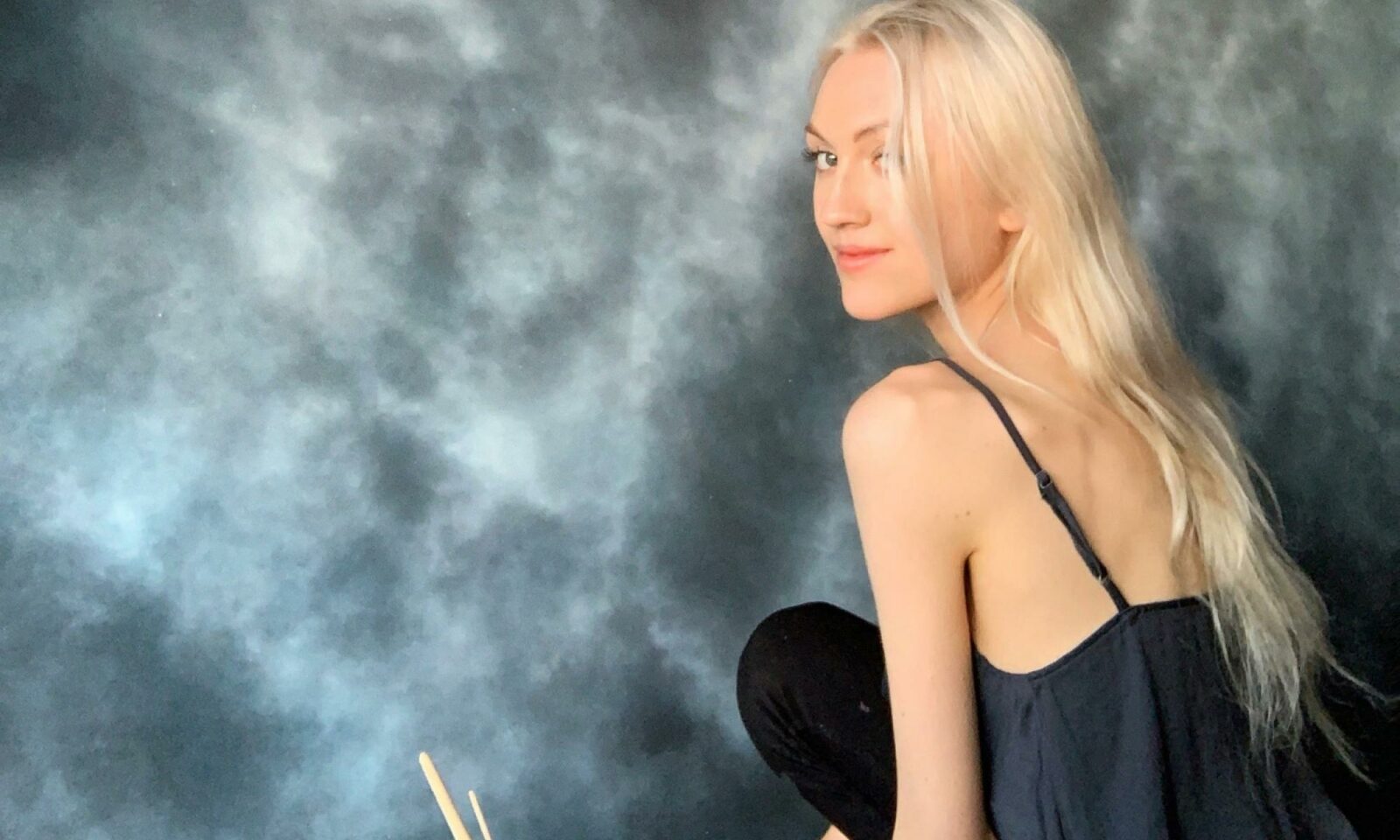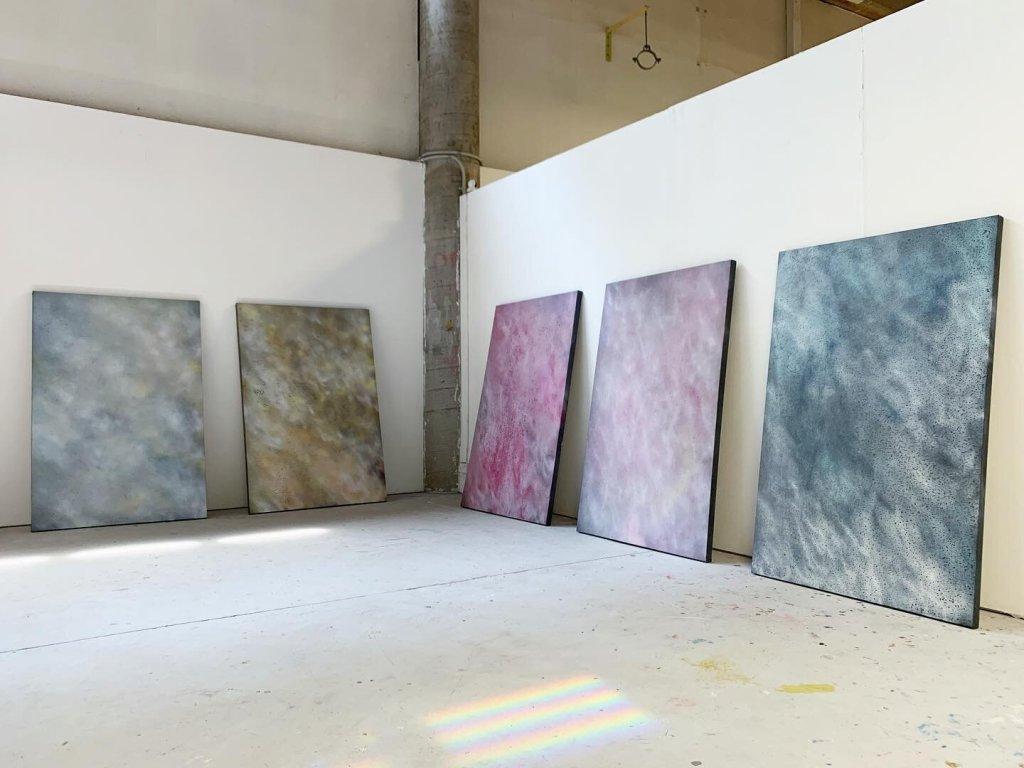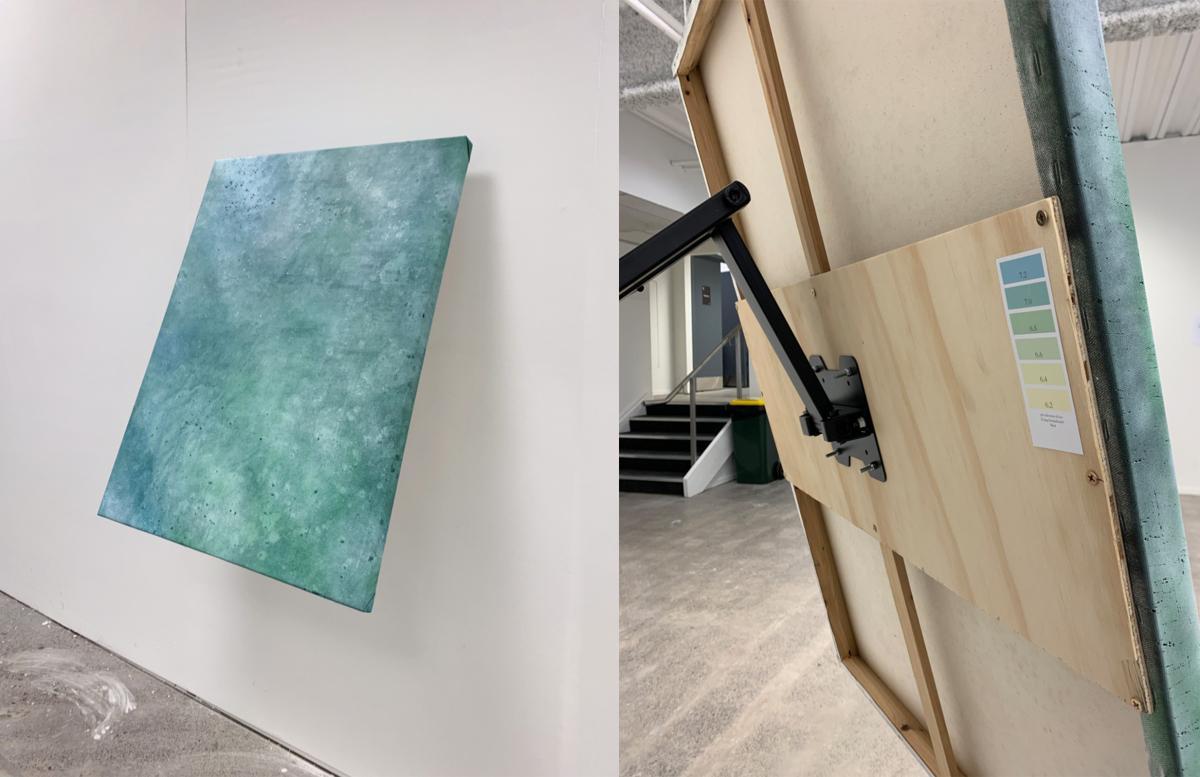Artist Isabella Young creates art using weather phenomenon to bring attention to climate change
As an environmentally conscious artist, she uses the sky, rain and other atmospheric processes as not only inspiration but also as active participants in the creation of her art pieces to bring awareness to climate change. Young's art installations, murals and weather paintings have gained critical acclaim for their conceptual depth and her work has been exhibited within Aotearoa and internationally.

Tell us a little about yourself.
Kia ora. I’m Isabella, a practising artist in Tāmaki Makaurau, Aotearoa, where my work explores a collaborative process with weather phenomena as an active medium and co-producer in order to shine light on the Earth’s condition. I have always felt intrinsically connected to and fascinated by the natural world. I spent a lot of time outdoors in my childhood, where I grew up in Kaipātiki North Shore alongside adventuring through my Nana’s farm in Te Awamutu every other weekend. My love for nature extends across the vast inter-connectivities of ecosystems, bodies of water, flora, fauna and other living beings. I’m passionate about caring for the environment which cares for us. Having been vegetarian for over five years, I am on an ongoing journey of reducing waste and minimising my environmental impact.
I’m currently in my final year studying a Master of Fine Arts at Whitecliffe College of Arts and Design. Beyond study, my time is filled with studio practice and art-making, meditating and spending time in nature, visiting art galleries or with friends and family. I also engage in semi-regular women’s groups which is an awesome space of support and feminine empowerment.
When and what led you to decide on art as a serious career path?
Art has always come as a natural expression for me—I’ve been painting, drawing and creating ever since I can remember. Upon graduating high school, I went directly into fine art study where I really trusted the path and delved into my art. I have felt so drawn to my creative processes that there really was no other option than to pursue my work. Some wonderful connections and opportunities have arisen and I am so grateful for it all.
How would you describe your style and what mediums do you work in?
Rainfall, light, mist, wind force, rising bodies of water, unpredictable and extreme events are explored as media. Ephemeral and spontaneous in nature, I am drawn to these forces and how they may be framed or documented as the climate is changing. Alongside working with weather phenomena, I predominantly work with fluid based media, dyes, paint and light-sensitive solutions. I’m drawn to their spontaneous nature and the flow that they create. Monochromatic works are especially fascinating for me and each singular piece will have an abundance of different tones, layers and variations of vibrancies. Technological apparatus and attachments are also explored as materials as they can enable a spatial activation that deepens the viewing experience. Robust and durable attachments, tilting mounts, coded systems and antennae may also draw parallels to weather instruments and meteorological territories which the work addresses
In recent years I’ve made a conscious change to use low environmental impact materials in consideration of the Earth’s wellbeing. This involves reduced toxicity media, biodegradable, repurposed and recyclable materials.
Tell us more about your shift to being environmentally conscious and about some of the eco-friendly practices you use.
Considerations around sustainably sourced materials and the impact they have upon the environment have become central around my thinking toward art-making. Each material and everyday item that we come across has been on its own complex journey. It is important to be conscious of the origin, chemical properties and environmental footprint that each of these materials has, as they will affect wider ecosystems and living beings in different ways.
Plastic-based paints with a long list of unrecognisable ingredients are a great example of media that holds negative environmental implications as they not only emit toxic chemicals and smells but will eventually wear into microplastics. Microplastics are known to be a large threat to ecosystems as they pollute bodies of water at an alarming rate and are detrimental to the health of living beings.
An alternative to these plastic paints with toxic qualities are paints that hold environmental certifications such as ‘carbon zero’ and ‘environmental choice.’ Paint Plus is a local shop which I often source supplies from, as they have such environmental certifications and also use a recycled process in store; collecting and reusing paint and their containers from customers.
What is the message you are trying to convey through your work?
As I am working with environmental, ecological and atmospheric issues within my work, I hope to stimulate conversation and conscious awareness to the agency we hold with our surroundings and to our own relationship with the Earth. Essentially, I hope to encourage positive change toward environmental resilience and restoration. I strongly believe that no effort is too small and that it will take collective action to look after our world.

Your art explores and depicts the sky, weather and other atmospheric processes. How did you develop these concepts and what was the inspiration behind them?
I have always been fascinated with the natural world and its preservation and protection. In my early art years, the elements were a recurring motif within my works and the conceptual layers have developed since. As I have learned more and more about environmental events and issues, they have only deepened my work.
I can remember being upset about climate change news I had heard during my final year at school. This heavily influenced my project going forward, where my artboards became a story about human-driven environmental destruction. But as a resolution to the series, the forces of nature were stronger in resilience.
My weather paintings manifested several years ago, where I was painting outside, working on an abstract sky piece. The clouds above were a heavy grey, and all of a sudden, it began to rain and hail upon me. I continued painting and once finished, brought the piece inside where I thought for sure it would be ruined. I was fascinated by the result, as the weather and precipitation itself had become embedded in the work. This was a really significant moment and I understood the deep potential that this way of art could produce.
What is your creative process? Do you pre-plan what the final product will look like or is it fair to say that your art is serendipitous?
Each piece is boldly serendipitous. Contextual research into the environmental condition is a significant part of the process, though studio practices and making will happen simultaneously. This includes research into local and global environmental issues, viewing weather maps and observations, reading scientific reports and doing field-based research and meditation.
As active weather forces and phenomena are employed, this means that the final work won’t be pre-planned—especially not in the aesthetic sense. Such forces hold their own agency and though they can be monitored and predicted to a degree, their qualities are unpredictable and sporadic. If the work is a painting that has been created with active rainfall, for example, the traces and droplets are completely spontaneous and reflect the time period it was created within. Colour choices may be chosen intuitively in reference to a surrounding element or they may have been chosen to represent a conceptual layer, like the colour of a pH reading.
You use real climate data and other tools to investigate climatic phenomenon which you then translate into your art. What have you learned about our weather and climate that surprised you in the process of creating your pieces?
It has been a fascinating phenomenon itself to work with and understand climatic data. Learning about the weather systems, ecosystems and greater climate has been really interesting, although it has stimulated within me a deep awareness and concern. I have been surprised to learn how much weather conditions and atmospheric qualities can vary between different locations and times, yet cyclical and repetitive seasonal patterns may be observed during the same time and location a year apart.
An example of this may be the sea temperature changes that happen around Tamaki Makaurau each year. The winter months hold the coldest temperatures due to ambient conditions, with August recording the coolest and February the warmest. With this phenomenon, I notice that the sea provides a beautiful cool blue hue in the winter months and in the summer, the sea reflects a turquoise.
During the lockdowns in Aotearoa between March and May of 2020, there was significant improvement in the air quality in the country and you created two monochromatic paintings in that period. Can you talk a little about those pieces, the impact of human activities on climate and your thoughts on how we can reduce this impact going forward?
On March 25 2020, Aotearoa began a national lockdown with restrictions, meaning a significant decrease of motor vehicles on the road, aeroplanes in the sky and operations of national factories. This meant the reduction of anthropogenic emissions such as carbon dioxide, carbon monoxide, nitrogen dioxide, nitrogen monoxide, particulate matter and sulfur dioxide. During the months of and surrounding this lockdown, I was taking rainfall samples from my home in Tamaki Makaurau for quality testing. The process involved pH testing, which is a measure of acidity or alkalinity. A digital reader was utilised alongside bromothymol blue drops to produce colour that would identify the acidity of the rain samples.
It was interesting to map the changes and fluctuations of the rain quality and understand the direct impact caused by anthropogenic emissions upon air and rainfall quality. On the days during lockdown when a large reduction of emissions was occurring, the rainfall quality was significantly greater and more alkaline. There is a direct link between rain and air quality, which means that the research conducted with rain samples would likely correlate to the greater quality of the atmosphere. I created a series of two paintings during the active rainfall with the sample findings on two separate days; one being April 20, 2020, during level four lockdown, and the other being May 3, 2020, once the restrictions had lifted. The colour of paint for each work was closely matched to the acidity of the rain sample taken during the time each was painted. [The pieces] pH 7.1 and pH 6.7 showed a significant difference in air quality when the nation was in or out of lockdown and anthropogenic emissions were at different levels.

The works were installed mid-year in the Whitecliffe studios, with a unique installation that drew connections to meteorological instruments and apparatus. A pivoting mount was attached to the back of each canvas support and to the studio wall so that the paintings could angle toward the sky. A pH test trip was also installed on the frame of each piece, enabling discussion and dialogue around the acidic quality.
The level four lockdown of 2020 was a unique opportunity to observe the atmospheric quality when there were significant reductions of vehicles on the road and in the sky, alongside the reductions of factories operating. I feel that these findings hold an important message upon the level of impact that our collective use of oil-based transport and carbon releasing activities have on the environment. We had the opportunity to see just how resilient and restorative the natural world is, returning to healthier rain and air quality within a matter of days and hours.
Moving forward, we now have the knowledge and opportunity to make positive change where possible. Whether walking, biking, taking public transport, carpooling or investing in an electronic car, significant emissions can be saved by each of us.
Can you elaborate on how art can be used as a tool for climate activism?
Artistic practice holds a unique platform which I’m so grateful to be engaged within. Art holds the ability to provoke emotion and to move people. Whether through painting, installation, poetry or performance, the deep level that art connects with people can itself stimulate awareness, conversation and action. In light of climatic context and concerns, art can stimulate conscious awareness and dialogue that may lead to informed action and positive change. I keep this in mind within my work which I hope to strengthen a bridge between environmental awareness and dialogue to encourage positive action.
Your artworks have a sense of calm—they all have a very therapeutic quality. Do you find the process of creating the pieces therapeutic?
Thank you, I’m glad to hear that you feel this quality within my works. I very much find the process of creating pieces therapeutic. Art is a way for me to express complex thoughts and emotions, and to process things that are occurring around and within. Regarding the contextual side of my practice, I love to learn. Although a lot of what is discovered about the environment through my research may be alarming or problematic, the feeling that gaining knowledge may help people in a way becomes a soul fuel.

In what ways do you believe art is a representation of the artist's frame of mind? How do you think an artist's mind frame impacts the art that they create?
There is a saying that an artist’s work is a reflection of society. This is very true in some respects, as our experiences, thoughts and emotions may be represented through art in a way that can collectively resonate and relate to others. However, I believe that art holds the ability to be more eternal too, an expression and extension of the inner world and infinities of the artist themselves.
What are some of the challenges you have faced as an artist?
There have been a few challenges for sure. But I feel like each has taught me something in a different way that I could learn and grow from. A huge eye-opener has been learning about the origin and complex journey that every material goes through before they reach us. It was quite problematic to learn about the carbon footprint and detrimental environmental impacts that are caused by many of our everyday objects and items. I’ve had to unlearn a lot of things that society tells us is good and tries to sell us. But this has been an opportunity to rise and embrace more eco-friendly materials and processes.
I have shared these findings with my close community where many have been making more informed decisions around the sourcing of everyday materials and items. As the awareness of environmental impacts is growing, more sustainable alternatives, processes and options are becoming available, which is very encouraging and exciting.
Are you able to share some advice for young and budding artists?
For sure. Some of the best advice I’ve received is to have faith in yourself and your art and to go all in. Your mindset is central to how you approach things, too. It’s important to keep an open mind around your practice and to be open to trying new things—this is where growth happens.
What’s next? Do you have any exciting upcoming projects? If yes, we’d love to hear about them.
Yes! I’m very excited to be working on a few upcoming projects. At the moment, I’m working on a digital air quality reader and how this may become embedded within a work and greater exhibition space. I’m also excited to be creating an interactive light work for an event coming up!
To learn more about Isabella's work, click here
Interview written by Julie Jacob, first published on The Love Post
Talk to our team

If you would like to ask us a question or request more information, please detail your enquiry using the form below. If you would like you can contact us directly on 0800 800 300, email us or use the contact us form.